Considered as one of the most powerful and influential civilizations of its time, the Persian Empire was a major hub in the region. Archaeology has revealed precious few clues about this great empire, but several excavations and studies have yielded some fascinating, albeit limited, information. It is perhaps this lack of information that most piques our interest.
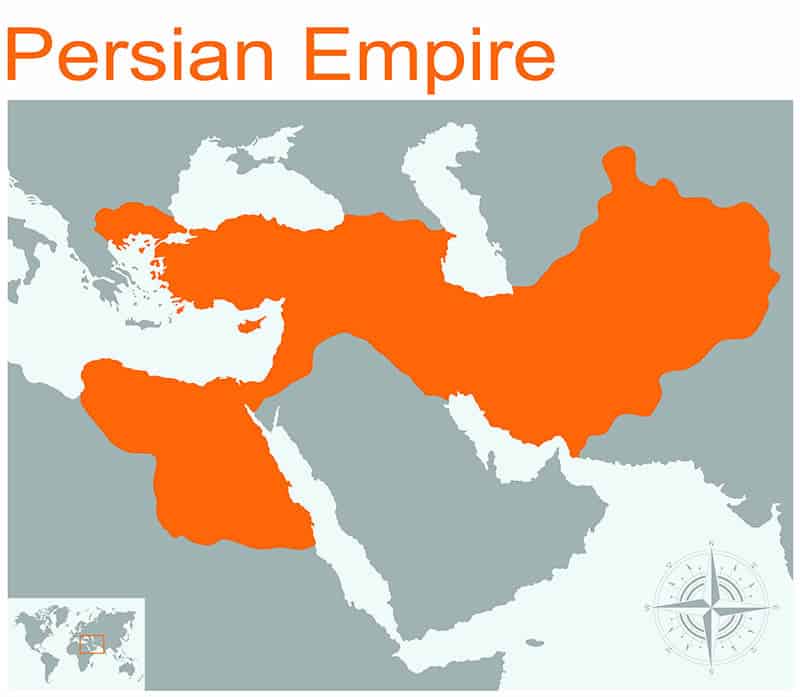
Here is a list of some of the most interesting and surprising facts about this ancient civilization:
1. The Beginning
The Achaemenid Empire is also called the First Persian Empire and was established by Cyrus the Great in 550 BC. The empire is said to have spanned the Balkans in the west and stretched to the Indus Valley in the east, covering an area of around 5.5 million square kilometers.
What made this empire different from the others was its acceptance of people from different origins and faiths. People were allowed to practice their religion without being discriminated against, and this tolerance attracted many citizens from nearby places. Other kingdoms did not grant such freedom during this era.
After the downfall of the Achaemenid Empire, several other successful empires followed, most notably the Parthians and Sasanians. The Parthian Empire was founded by Arsaces I of Parthia, the leader of the Parni tribe, and lasted from 247 BC to 224 AD. Under the Parthians, the empire was a significant political and cultural power.
Before the Islamic conquests changed the face of Persia in the seventh century, the last great Persian empire was the Sasanian Empire. Their rule began after the fall of the Parthians and lasted until 651 AD. Many early Islamic artforms have their basis in the Sasanian culture.
2. Gardens of Persia
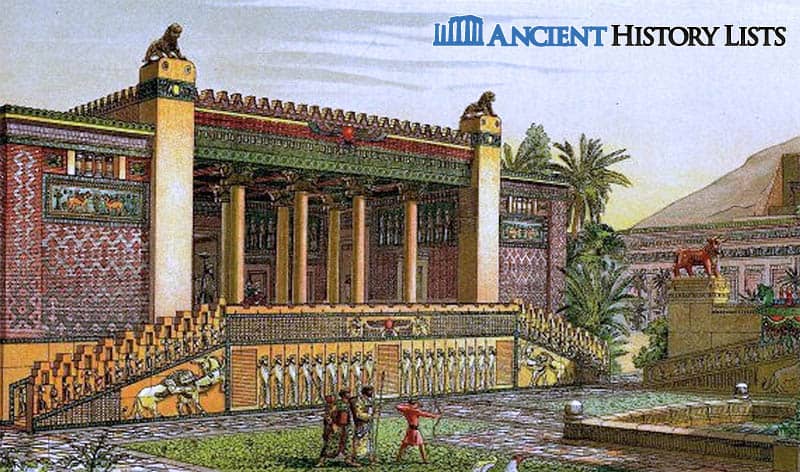
Persian gardens are an example of Persian architecture and design at its best. These beautiful and elaborate gardens were designed to provide comfort from the harsh weather conditions in an area that was mostly desert; the summers were hot and the winters were cold.
Pasargadae, the first capital of the Achaemenid Empire, has the oldest and perhaps the most elegant example of a Persian garden. The gardens at Pasargadae were excavated by David Stronach who is an expert in the study of ancient and medieval Iran and Iraq.
Lined by exotic trees, orchids, and water channels, they were places for social gatherings and leisure time for the Persians. Within the gardens themselves, there were stone-lined streams in rectangular patterns, and mud-brick walls enclosed the whole garden for protection.
The word “paradise” comes from the old Persian word pardeiza which translates as “a wall around,” implying that it was used to describe an enclosed space. Indeed, the gardens would have been a paradise – an oasis – during their time. After the Islamic conquests, the design principles of these gardens were fused with Islamic architecture to create the classic Islamic gardens.
However, mud-brick gardens require a lot of maintenance owing to their brittle nature, and as a result, very few gardens have survived.
3. Charter of Rights
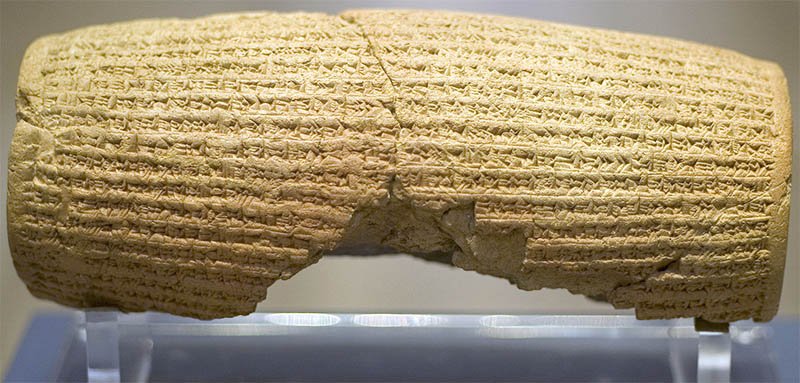
In 1776, the United States adopted the Declaration of Independence, giving people certain inalienable rights by birth. Soon after this, the French Revolution saw the creation of the Declaration of the Rights of Man and the Citizen in 1789 based on similar principles. While these two events marked the beginning of human rights in the modern world, the Persian Empire had adopted a Charter of Rights 2,000 years before.
Cyrus the Great wanted the people of his kingdom to have equal rights and freedom to practice their religion. An artifact called the Cyrus Cylinder was found amongst the Babylonian ruins in 1879. It was 22.5 centimeters (8.85 inches) long and made of baked clay. On the cylinder are engraved the thoughts of Cyrus with regard to racial, linguistic, and religious freedom. It also showcases his generosity towards the Babylonians whom he defeated in 539 BC to establish his own empire.
He has been hailed as a great patron, supporting the people and improving their lives, but some critics argue that the cylinder was a glorification of the great king and that his actions were to appease the gods more than to help his people. However, archaeologists and historians unanimously agree that the artifact is indeed a beautiful representation of Persian history.
4. The Royal Road
Darius the Great built a highway connecting the Persian Empire from Susa to Sardis. His aim was to ensure smooth and rapid communication across the vast empire.
The distance between the western and eastern borders was 1,700 miles; it took 90 days for foot travelers to walk the length of the road and a mere nine days for couriers on horseback. Caravanserai, or royal outposts, were established by Darius the Great along the roadside for foot travelers. The people traveling this route were known as caravanners, hence the outposts’ names. These caravanserai soon became hubs for trade, commerce, and the exchange of information.
5. Persian Rugs
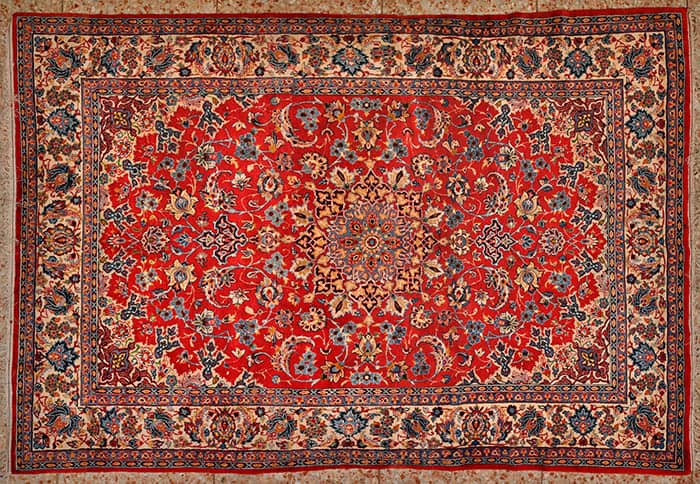
The Persians were often subjected to harsh weather, especially in winter. To battle the cold, the Persian tribesmen, who were mostly nomadic, weaved carpets and rugs as a necessity. As the empire consolidated and trade grew, these rugs became an art form. Their versatile designs and patterns made the rugs popular, and soon they were an important export.
It is estimated that carpet-making originated around 2,500 years ago, and with every conquest or invasion, the style of the carpets and rugs changed. Cyrus the Great was so awestruck by the beauty of the designs and patterns on the carpets that he had his tomb in Pasargadae near Persepolis covered in carpets and rugs.
The oldest-known carpet to have been discovered was in the Altai Mountains of Siberia. The frozen lands of Siberia helped to preserve the carpet, and it gives us an insight into the skills which existed in ancient times. The patterns on the carpet show that carpet-weaving had progressed beyond simple designs. The rug is now exhibited in the Hermitage Museum of St Petersburg.
6. Murex Dye

The most expensive and prized possession of the Persians was a purple dye obtained from murex shells. The shells contained a reddish-purple dye, getting their color from their high bromide content. It was a rare and costly item. Persian royalty and other wealthy families were in a race to obtain it as its primary use was to color ceremonial robes.
The dye was also known as tyrian purple, and as the color was similar to that of clotted blood and the Persians believed that such a color had a divine significance, they were keen to keep it out of reach of the rest of the population. Even the alternatives with similar purple colors became expensive owing to the popularity of the dye.
7. Roses
Considered a symbol of love and friendship, roses were a gift from Persia to the entire world. They remained native to Persia and its nearby territories for a long time. The yellow Persian rose was the first variety of the flower to be traded, reaching Vienna sometime in the 16th century. From there, it slowly gained prominence across Europe and the world for its color and fragrance.
8. Pets
The Persians were very fond of hedgehogs and dogs. Hedgehogs were kept in homes as protection from pests and ants. Domesticated hedgehogs were banned after the Islamic conquests, but people were willing to pay a huge amount in taxes to keep their domesticated hedgehogs. Another animal which the Persians were fond of was the dog, and exotic dog breeds were kept for good luck. Dogs were nurtured and treasured by the Persians and considered sacred.
9. Military Training
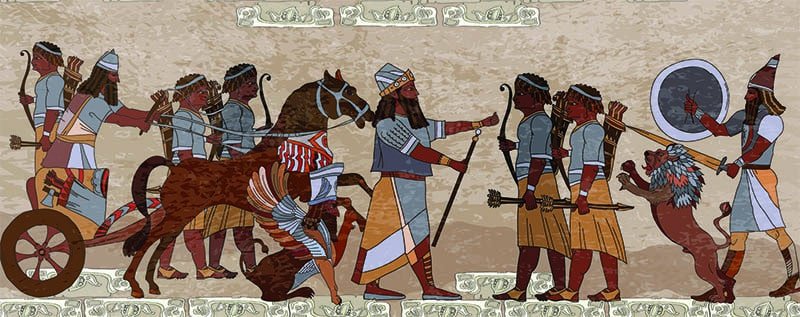
Military training was an essential aspect of the ancient Persian Empire. Persian boys would receive military training between the ages of five and 20 as the empire needed a large army to defend its vast borders. The size of the king’s army is thought to be over 100,000 which would have made it the largest army of that era.
The Persian army was the first to adopt matching uniforms for all of its soldiers. A standard uniform was given to each soldier. The strength of the army lay in its men’s superior horse-riding skills, and this powerful cavalry enabled them to conquer the great landmass of West Asia.
Within the army were elite soldiers called the Immortals or the “human tanks.” This was because each Immortal was equipped with the following weapons: a bow and arrow, a spear, a sword, armor, and a shield. They were thought to number around 10,000 in total.
10. The Curious Case of Queen Atossa
Queen Atossa was the daughter of Cyrus the Great and his wife Cassandane, and the wife of Darius the Great. She suffered from breast cancer and had a lump in her breast removed. She survived the surgery and was probably the first individual in history to be documented as having suffered from, and survived, the disease. Later in life, she helped Xerxes I, her eldest son, to become the next King of Persia. It was her support that helped Xerxes win the crown since he was not the eldest son of Darius.
11. Alexander’s Conquest
Alexander the Great was a great admirer of Cyrus the Great, but he ultimately broke the supremacy of the Persian Empire in a decisive campaign that lasted for 10 years. His victories in Anatolia, Issus, and Gaugamela reduced the strength of the Persians substantially. Darius III was overthrown, and the Persian Empire came under Macedonian rule.
After Alexander’s death, there was a great power struggle over his kingdom. His successors were not strong enough to keep control of the empires, and eventually the Parthians took control of northeast Iran. Thus began the era of the Parthians.
12. A Grim Festival – The Slaughter of the Magi
The Persians committed one of the earliest holocausts in recorded history. The Magi were immigrant priests living in Persia, and they followed their own sets of beliefs and practices. The Magian priests were kept in the royal courts and played a pivotal role in many important ceremonies.
However, Darius I and his nobleman made them scapegoats in a political plot. After gathering the support of the Persian people, they slaughtered every Magi in the royal courts and streets, wiping them out overnight. What’s intriguing is that every year, the event was celebrated as an annual holiday – the Slaughter of the Magi.
13. The Original Vineyard
Persia is often regarded as the birthplace of wine. Winemaking was popular in Iran even before the Babylonian or Achaemenid empires, and excavations in various ancient Persian cities have revealed jars from the Neolithic age (as far back as 5000 BC) with evidence of high tartaric acid. This is an indication that the liquid inside the jar was made from grapes.
The city of Shiraz was a hub for grape and wine production, and there is evidence of grape cultivation in the city dating back to 2500 BC. The famous poet Hafez immortalized Shiraz wine in his writings. In the Parthian Empire, wines made in the city of Ramian in northern Iran were also very famous.
14. Trading Through the Suez Canal
The Egyptian pharaoh Necho can be credited for building an earlier version of the Suez Canal in 600 BC, but the project was abandoned when the canal was only half complete. Darius I, one of the many kings of the Achaemenid Empire, wanted to boost trade between Egypt and the Gulf regions so, after consultation with his experts, he initiated the construction of the remaining canal which would connect the Nile and the Red Sea. The construction was completed in around 500 BC and he named it the Darius Canal.
The Darius Canal covered a route similar to the present Suez Canal which starts at the Nile Delta and crosses the Bitter Lake near the port of Suez. It was 50 yards wide and ceased to operate in 8 AD.
15. The Palace of Persepolis
Darius had a vision of building a luxurious palace complex which would allow him to entertain guests en masse. So, in 520 BC, he began the construction of Persepolis in the southern region of Iran. After his death, his successors completed the build and the palace lasted for approximately 200 years.
The entire palace was made from wood including special cedar beams transported from Lebanon. These beams could hold a heavy weight by distributing it equally throughout the structure. In addition, 36 wooden pillars were used to provide support to the roof of the palace’s large hall complex. The palace hall could accommodate 10,000 guests.
There are many myths as to how the palace got its name; some believe it was named after the city of Persepolis whilst others called it “the palace complex of Parsa” which was a Persian province. In 331 BC, the Persian palace was burnt to the ground when Alexander invaded.
16. The Kings of Kings
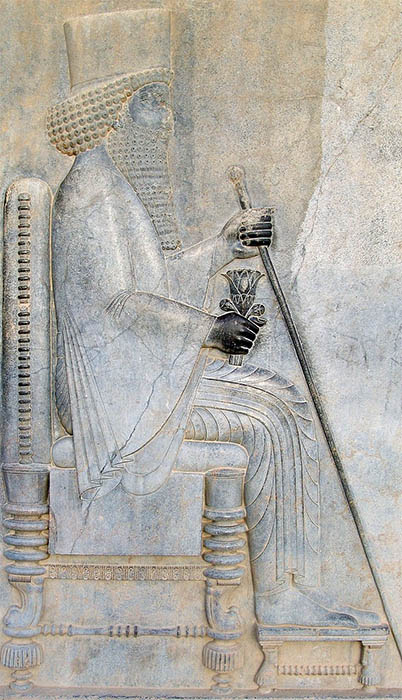
Persian rulers developed a taste for the extravagant which was evident in their choice of food, and clothing, and in their lifestyles. Persian kings wore trousers called pajamas which were made from fine material such as silk, leather, and wool, and were decorated with detailed embroidery to add a royal touch.
All ancient Persian rulers adopted the title Xšâyathiya Xšâyathiyânâm which translates as “kings of kings.” The reason behind this was their desire to exercise control over all subjects, and it also made them superior to other provincial rulers who were called satraps. This tradition started with Cyrus the Great and continued until medieval times.
17. Multistate and Multicultural
The Achaemenid Empire was a true multistate realm with four capital cities: Babylon, Susa, Pasargadae, and Ekbatana. The kingdom was further divided into numerous provinces, each with its own provincial ruler called a satrap. Usually, the satrap was chosen by the king or a nobleman, and they were responsible for maintaining decorum and order within the province. Each satrap also had government officials such as record keepers, chapars, and generals working under them.
The Kingdom of Persia was home to people of several nationalities and religions. Under his rule, King Darius allowed the citizens to practice their choice of religion and also promoted the unity of cultures.
18. Persian Linguistics
It is generally believed that in the Achaemenid Empire, people spoke and wrote in Old Persian. The Old Persian dialect had similarities with Sanskrit and Avestan, the language of the Zoroastrian scripts and scrolls. However, after the Achaemenid Empire was defeated, the native dialect changed to Middle Persian, also called Pahlavi.
Pahlavi was widely spoken in the province of Pars, but very few examples of Pahlavi literature survive today. After the Arab invasion, it was necessary for the people to be able to speak Arabic, but even then Pahlavi was spoken locally. Later, the Pahlavi dialect evolved into Modern Persian or Farsi. Farsi is still spoken today and is the national language of Iran. In Afghanistan, it is called Dari, while in Tajikistan and Uzbekistan it is written using the Cyrillic alphabet.
Ghazals are Persian poems. The most important parts of these poems are their introductions which often celebrate wine, love, and nature. This form of poetry was extensively used on ceremonial occasions and during festivals.
19. Strict Parenting
The noble classes of ancient Persia had very strict parenting policies. It is thought that young boys couldn’t meet or even see their fathers until they reached the age of five. Afterwards, the parents would enroll the boys in a strict training regime which focused on teaching them three primary skills: horse riding, using a bow, and speaking only the truth. They would undergo this training until the age of 20 when they would follow it up with rigorous military training for a further four years.
20. The Armed Forces
The Greek historian Herodotus describes how Persian boys (mostly belonging to the elite class) were trained for battle until the age of 20. But another historian, Strabo, describes the military training as lasting until the age of 24 and says that training was provided to every man irrespective of his class. Strabo also explains that groups of 50 soldiers were usually controlled by the son of a noble officer. Every soldier would be enlisted in the Persian National Army until the age of 50 in times of peace and war.
Another Greek philosopher, Xenophon, states that the Persian army had a total of 120,000 Persian soldiers. The philosopher Herodotus also states that the Persian army maintained an immaculate appearance with each soldier dressed in an identical uniform, a practice that was uncommon in ancient times.
In fact, it is believed that Cyrus II would gift capes to the nobles as well as slightly lower-ranked officials. The capes were made from the finest fabric and came in different colors such as purple, crimson, and dark red. It is thought that the capes were used to maintain uniformity of appearance amongst the soldiers.
The soldiers in the Persian army were divided into regiments of 1,000 soldiers also known as hazaraba. A total of 10 hazaraba were combined to form the baivaraba, and they acted as the king’s royal guards. They also went by the name of amrataka which translates as “immortal.” This was because the number of soldiers would always remain at 10,000. If a soldier was injured or fell sick, he would immediately be replaced by another healthy candidate.
Lastly, Herodotus states that the baivaraba had beautiful clothing and armor. The soldiers wore gold ornaments, and their uniform consisted of trousers and beautifully woven tunics overlaid with a coat of mail similar to fish scales. For armor and weaponry, they had small spears, small swords, stiff bows with cane arrows, and wooden shields for protection. Their women and servants followed them everywhere in carriages filled with food, clothes, and other supplies.
21. Political Structure
The Persian Empire grew rapidly under the rule of Cyrus I. After his death, his son Cambyses II took over the throne and continued the expansion. With expansion came the requirement for a formal administrative structure, and this was implemented by King Darius I.
Under this formal administrative structure, approximately 20 to 30 provincial leaders were appointed by Darius. These provincial leaders were called satraps and they usually came from noble Persian families. The satraps were responsible for maintaining law and order in their region and also for implementing the laws and taxes imposed by the king.
To prevent the misuse of power, Darius also introduced a control system which helped to keep the satraps in order. Regular audits were conducted by royal personnel in every satrap province to keep a check on the satraps and to ensure smooth operations.
22. Satraps
A satrap was a provincial governor of the ancient Median and Achaemenid empires. Members of the royal family or Persian nobility were generally given the position of satraps as well as serving as governors to the king. It was Darius I who divided the empire into provinces called satrapies and established 20 satrapies with their annual tribute. The satraps were the administrative heads of these provinces. Their core duty was to collect and implement taxes, and they also enjoyed supreme judicial authority. They were responsible for internal security and maintaining the army.
23. Zoroastrianism
Zoroastrianism is one of the oldest religions in the world and is still practiced today. It is an ancient pre-Islamic religion from Iran that probably originated around 4,000 years ago. In India today, the descendants of the Zoroastrian Persians are known as Parsis.
Zoroastrianism played a very significant role in the shaping of Persia. It was founded by the Iranian prophet Zarathustra and was considered as the state religion of three major Persian dynasties. The founder of the Achaemenid Persian Empire, Cyrus the Great, followed Zoroastrianism and ruled by the Zoroastrian law of Asha, i.e. truth and righteousness, but he didn’t impose Zoroastrianism on his non-Iranian subjects. He gave them the freedom to practice their own religion. Fire is the symbol of Zoroastrianism whereas fire along with water is considered a symbol of purity. Zoroastrian places of worship were called fire temples.
Conclusion
Ancient Persia was a vast empire which has given the modern world not only history but also art, architecture, and culture. The contributions of the empire were vital for the development of civilizations in other parts of the world. While a lot is not yet known about the empire, from the evidence we do have, it is clear that the Persians were highly advanced for their time and had a varied and vibrant culture.